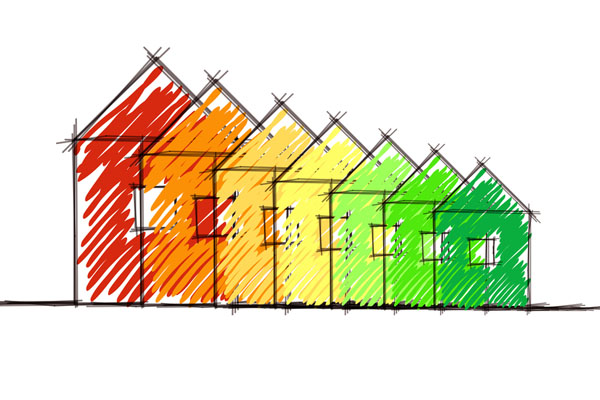Contents
 Per the Energy Star, almost 50% of your overall energy costs can be attributed to your home’s cooling and heating system. Making smart decisions when it comes to your system’s repairs, replacements, and maintenance is one way you can lower your energy bills. With regards to your heating system, familiarize yourself with AFUE as it has a direct impact on your energy consumption and costs. This is especially important when you have an old, outdated furnace and you’re facing a heating system replacement. Read on to learn more about AFUE rating.
Per the Energy Star, almost 50% of your overall energy costs can be attributed to your home’s cooling and heating system. Making smart decisions when it comes to your system’s repairs, replacements, and maintenance is one way you can lower your energy bills. With regards to your heating system, familiarize yourself with AFUE as it has a direct impact on your energy consumption and costs. This is especially important when you have an old, outdated furnace and you’re facing a heating system replacement. Read on to learn more about AFUE rating.
AFUE Rating Definition
The Annual Fuel Utilization Efficiency (AFUE) was created by the American Society of Heating, Refrigerating, and Air Conditioning Engineers (ASHRAE). It is represented as a percentage and measures a heating system’s energy efficiency. Generally, AFUE can be defined as the ratio of the generated heat versus the heating unit’s total fuel usage.
Calculating the AFUE rating of your heater is as simple as dividing the amount of fuel used by the unit by the amount of heat produced, typically in British thermal unit or BTU. For example, an 85% AFUE value translates to 15% of the fuel energy being lost to inefficient chimneys and burners, and only 85% is used for heating. Note that the AFUE doesn’t factor in the heat lost in the HVAC pipes and ducts. There could be a significant amount of heat lost. After all, the US Department of Energy (DOE) states that the ducts in unconditioned areas such as attics and garages can have up to 35% loss of furnace energy output.
Generally, a high AFUE value means higher energy efficiency and vice versa. As a result, you can enjoy lower fuel costs when you have a unit with high AFUE ratings. Keep in mind that electric heat pumps do not use AFUE in heating mode. Instead, they utilize the Heating Season Performance Factor (HSPF). The US DOE currently uses AFUE to indicate a heating system’s combustion efficiency. It is set as the national measurement standard.
The DOE has set a minimum AFUE rating for gas heating systems as a means of energy efficiency promotion throughout the country. It is currently at 80% for the Southwest region and 90% for the Northwest region. This resulted in nearly all new furnaces having 90% AFUE ratings or higher.
How To Find The AFUE Rating
The Federal Trade Commission mandated that all manufacturers of boilers and furnaces should indicate the AFUE ratings of their products to help consumers make the right choices. Most manufacturers put this information in the yellow tag called the EnergyGuide label. Most appliances have this tag. If the EnergyGuide label doesn’t contain the rating or there is no label, check the owner’s manual or the website of the retailer or manufacturer. Remember that the energy efficiency of heating systems reduces over time. This results in the printed AFUE rating being higher than the actual rating of your heating system. Therefore, have an HVAC professional help you determine the actual AFUE rating of your system.
What Is A Good AFUE Rating?
The DOE narrates that a good AFUE rating is those above 80% and 90% for the Southwest and Northwest regions, respectively. Unfortunately, heating systems usually become less efficient over time. Under-performing or old heating units can have as low as 56% to 70% AFUE ratings. The standards of the DOE mandate that the AFUE ratings of new systems should have a minimum of 78%. Per the AFUE ratings, heating systems are divided into three classifications: low-efficiency systems or those with less than 80%, mid-efficiency systems with 80% to 89%, and high-efficiency systems or those systems with 80% to 89%. The highest AFUE rating is at 97% to 98.5% due to the inefficiencies of heating systems like firing and distribution losses.
How Can Homeowners Use AFUE Ratings?

AFUE rating measures a furnace’s efficiency during its operation. Furnaces lose efficiency as time passes, so older and non-efficient furnaces have lower AFUE ratings. The heating systems sold in the United States were not required to meet minimum AFUE ratings before 1975. In 1987, the DOE mandated that systems have a 78% minimum AFUE rating, which was raised to 80% in 2015. Furnaces that are 15 years old or over are typically inefficient, so they are costly to run. Getting a system replacement with a low-efficiency AFUE rating will result in higher energy savings and lower energy bills than your old one. Select a furnace with a higher rating to receive more savings. Currently, the most energy-efficient systems on the market have a 98.5% AFUE value. It is worth noting that the AFUE rating you choose will greatly affect your energy costs and carbon footprint.
Should I Buy A High-Efficiency Furnace?

Before answering this query, consider some factors first. One is the region where you live. You will use a furnace more often if it is in a relatively cold area, so it is best that you get a high-efficiency furnace. This way, you will have more savings over time. A high-efficiency furnace can have as much as 18.5% more efficiency than low-efficiency systems. According to different studies and figures, American households spend an average of $600 or more on heating annually. You can have up to $111 in savings per year when you have a high-efficiency system.
You also need to consider your budget. The average cost of high-efficiency furnaces is about $1,000 more than furnaces with mid-efficiency. However, furnaces generally have a 15 to 20 years lifespan. Therefore, saving $111 for 15 years means you will have more than $1,600 in savings. Over time, you will get back the additional cost of HVAC system installation.
Features of High AFUE Furnaces
In general, high AFUE furnaces are equipped with new technologies and features, so you receive unequaled energy efficiency. Several exceptional features these systems have are:
- Variable-speed blowers
- Variable-heat output
- Secondary heat exchanger
- Direct spark ignition systems
- Improved air filtration systems
Conclusion
AFUE measures the energy efficiency of a heating system. It is what the US Department of Energy uses to set efficiency standards for furnaces. All furnaces sold in the United States are mandated to have an 80% AFUE rating or higher.
Call Wilcox Energy For All Your HVAC Requirements

Wilcox Energy provides high-quality heating and cooling services throughout the southern Connecticut shoreline. We have the best professionally certified and highly skilled technicians for all your HVAC service needs, such as maintenance, installations, replacements, and repairs. All our techs can service your HVAC system correctly using their knowledge and experience.
Our company offers highly affordable HVAC service rates in the locality. Our tune-up services help you achieve higher energy efficiency and better home comfort with reduced energy costs. If you need to replace or repair your HVAC system, we can recommend the most suitable and budget-friendly one for your home. Your satisfaction is important to us, so all our work is guaranteed. Call Wilcox Energy to schedule a service appointment today. We offer free, in-home estimates.
For more information about our HVAC services, be sure to contact Wilcox Energy. You can click here to contact us, or you can call us at (860) 399-6218 to find out more. We offer a full line of heating and cooling repairs, maintenance services, and installations.
